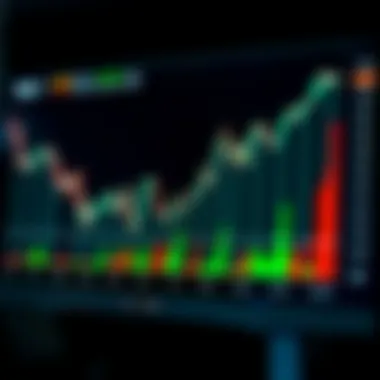Analyzing VIIX Stock: Insights and Trends


Intro
In the fluctuating world of stock trading, understanding the nuances of specific stocks is paramount. One such stock that has captured the attention of investors is VIIX. While many may have heard of it, only a few grasp its potential impact on their portfolios. This analysis delves into the factors that shape VIIX's performance in the market, examines vital metrics, and explores what it means for your financial strategy.
By diving into state-of-the-art market trends, we aim to paint a clear picture of VIIX's landscape, revealing its strengths and weaknesses. This exploration is designed not just for seasoned investors, but also for novices looking to comprehend the broader context of stock investments. Let’s embark on this journey to demystify VIIX.
Investment Terminology
Understanding the language of investing is crucial. The finance world has its own lingo, and it can be a maze for newcomers. Here, we will break down some essential terms that are often associated with VIIX stock.
Key Terms and Definitions
- Volatility: This indicates the degree of variation in trading prices over time. In the case of VIIX, volatility can show the risks and opportunities present.
- Liquidity: Refers to how easily an asset can be bought or sold in the market without affecting its price. When assessing VIIX, a close eye on liquidity can offer insights into trading strategies.
- Market Capitalization: This indicates the total value of a company's outstanding shares. It's crucial when comparing VIIX to other stocks in the same sector.
Common Acronyms in Finance
- P/E Ratio (Price-to-Earnings Ratio): This ratio helps investors evaluate a company's share price against its earnings. A high P/E ratio may mean investors expect future growth.
- ETF (Exchange-Traded Fund): A type of fund that is traded on stock exchanges. Understanding if VIIX is linked to any ETFs can help you gauge its performance more effectively.
- ROI (Return on Investment): This metric is critical for any investor. It shows the profitability of an investment and gauges VIIX's potential returns.
Expert Insights
When navigating investments in VIIX, gleaning insights from experts can make a world of difference. Below are thoughts on strategic approaches and tips garnered from seasoned investors.
Investment Strategies Overview
Investing in stocks like VIIX involves various strategies:
- Buy-and-Hold: This involves purchasing stocks for a long period, betting on their appreciation over time. This suits affiliate investors who believe in VIIX's long-term viability.
- Trend Following: This method entails analyzing stock charts to identify trends. If the indicators signal upward trends for VIIX, this may prompt timely buying.
- Diversification: Spreading investments across various assets can lower risks. Adding VIIX to a diversified portfolio could mitigate volatility.
Tips from Financial Advisors
Here are some practical tips for investors curious about VIIX:
- Do your homework: Research not just VIIX, but also the sectors it intertwines with to form a broader understanding.
- Watch for news: External events – be they geopolitical or economic – can impact stock performance. Staying informed can help you anticipate changes.
- Have an exit strategy: Knowing when to cut losses or take profits can protect your investment in the long run. This strategy doesn’t just safeguard your capital but can also ensure you reap the benefits of your gains.
"Investment isn't about beating others at their game. It's about controlling yourself at your own game."
Finale
In summary, investing in VIIX stock isn't merely a transaction. It's an intricate dance that requires understanding market dynamics, keeping a pulse on current trends, and employing calculated strategies. By refining your investment terminology and seeking expert insights, you can navigate this complex landscape more effectively. For deeper knowledge, resources like Investopedia and Yahoo Finance offer valuable information.
Prolusion to Stock
Diving into VIIX stock is like peeling an onion—each layer offers insights that can either bring you to tears or unveil something truly valuable. As investors navigate the complex landscape of financial markets, understanding a specific stock's dynamics becomes crucial for informed decision-making. In this article, the focus is on VIIX and its various intricacies, which are pivotal for both seasoned traders and those just starting to dip their toes into the stock market.
When we discuss VIIX stock, it's not merely about numbers and charts. It encompasses the essence of a company’s performance, current market conditions, and potential future growth. Investors must grasp how these elements interplay within the broader market context. This is where the relevance of exploring VIIX stock comes into play.
A comprehensive analysis of VIIX stock helps in several ways:
- Knowledge Gathering: For beginners, familiarizing oneself with VIIX introduces the fundamentals of stock investing. More experienced investors can refine their strategies and understand market positioning.
- Investment Strategy Development: Understanding the nuances of this stock allows investors to tailor their investment strategies. Whether looking for long-term growth or short-term gains, knowing VIIX's potential plays a pivotal role.
- Risk Assessment: By breaking down the performance of VIIX and the factors influencing its market behavior, investors can better assess associated risks.
Understanding the Company Behind
At the heart of any stock is the company that issues it. VIIX is rooted in an industry that may not be widely known, but its influence grows as new technological advancements shape the market. The company focuses on innovative approaches, whether through alterations in its service models or product offerings. Investors should delve deeper into the operational strategies, market presence, and management team that steer VIIX.


The historical context also matters. For instance, how did VIIX cope with economic downturns? What measures were taken to adapt in changing market climates? Such insights can provide a fuller picture of the company's resilience.
The Nature of the Stock Offering
Moving from the company to its stock offering, it's essential to explore the attributes that define VIIX. The stock might be characterized by volatility, which needs to be balanced with the potential for growth. Investors should consider the offering structure—is it primarily focused on volume trading or does it attract a specific niche of investors?
Investors often look into stock offerings concerning dividends, growth potential, and liquidity. Understanding how VIIX positions itself in these areas helps in making clear-minded investment decisions. For instance, if VIIX offers dividends, how consistent are they? Or, if it's more oriented towards capital appreciation, how does it plan to achieve this in a competitive market?
Ultimately, assessing the nature of VIIX’s stock offering is not just about numbers; it reflects strategic choices made by the company's leadership and the anticipated market reactions. Being aware of these factors is integral when navigating your investment choices.
Market Performance Overview
Understanding the market performance of VIIX stock is essential for investors looking to navigate today’s complex investing landscape. The stock market is like a reflective surface; the movements of a stock mirror not just the fortunes of a company but also broader economic conditions and investor sentiment. Knowing the trends and metrics can give both rookie and seasoned investors a edge while they formulate their strategies.
Recent Trends in Stock Prices
Examining recent trends in VIIX stock prices reveals valuable insights into how the stock has performed over the past months. For instance, fluctuations in the stock price can often indicate market sentiment or significant events affecting the company or the sector it operates in.
In the last quarter, for example, VIIX saw an upturn in pricing, climbing approximately 15% since the previous quarter. This upward trend might be attributed to positive earnings forecasts, a steady stream of investor interest, or perhaps broader market rallies that have occurred recently. However, prices can swing like a pendulum; thus, investors should monitor for potential downturns that can come without a moment's notice.
Take into account some key metrics here:
- Price Movement: A consistent upward trend can signal confidence in the stock, while drops can raise flags for potential issues.
- Historical Performance: Past price history can be a useful indicator of future performance. Studying previous price movements related to earnings releases, market events, or industry news can provide context.
Volume and Liquidity Analysis
In the world of stocks, volume is the lifeblood that keeps the system alive. Volume refers to the number of shares traded over a specific period, while liquidity measures how easily those shares can be bought or sold without impacting the stock price significantly.
For VIIX, recent trading volumes have shown an impressive uptick, indicating higher interest from investors. When volume increases alongside price appreciation, it’s usually a good sign—suggesting strong demand. However, if the price is rising while volume is declining, it can signal potential weaknesses in investor confidence.
A solid volume analysis would reveal:
- Average Trading Volume: Assessing daily average volumes can help investors identify any patterns or anomalies in trading. For instance, a higher average might suggest increased interest or speculation.
- Liquidity Metrics: A liquidity ratio can also help gauge how quickly VIIX stock can be sold. A ratio close to one typically indicates that the stock can be traded without significant price impact.
"In short, an effective trading strategy hinges not just on the stock price, but also on the volume dynamics that accompany those price movements."
Understanding these elements contributes significantly to grasping VIIX's overall market performance and lays a solid foundation for making informed investment decisions.
Analyzing Financial Metrics
Analyzing financial metrics plays a crucial role in assessing the value and performance of VIIX stock. These metrics provide a quantitative foundation for understanding the company's profitability, efficiency, and overall financial health. Investors, both newbies and veterans, benefit significantly from a keen grasp of these figures since they form the backbone of informed decision-making.
When evaluating VIIX, one must take a closer look at key performance indicators (KPIs) such as earnings reports and valuation ratios. Such metrics not only reveal insights into past performance but also pave the way for forecasting future trends. Ultimately, understanding these numbers helps demystify the seemingly complex world of stocks, positioning investors to make well-thought-out choices.
Earnings Reports: Insights and Implications
Earnings reports are like the report cards of publicly traded companies. They give a snapshot of financial performance over a specific period, detailing revenues, expenses, and net income. For VIIX, these reports hold substantial weight; they paint a picture of how well the company is performing against its previous benchmarks and market expectations.
Understanding these reports is vital for investors seeking to gauge the stock's viability. For instance, if VIIX consistently meets or beats earnings expectations, it can boost investor confidence and positively impact stock prices. On the flip side, if the company underperforms, it can lead to stock price slumps. Thus, staying abreast of VIIX's earnings reports enables investors to make timely decisions based on concrete data rather than speculation.
Valuation Ratios and Comparisons
Valuation ratios are indispensable for determining if a stock like VIIX is overvalued, undervalued, or fairly-priced. These often-used metrics help investors compare the value of a stock against its peers or the broader market.


Price-to-Earnings Ratio
The Price-to-Earnings (P/E) Ratio is one of the most commonly referenced valuation metrics. This ratio compares a company's current share price to its earnings per share (EPS). A higher P/E ratio might suggest that investors are expecting future growth, while a lower P/E might indicate that the stock is undervalued.
In the case of VIIX, the P/E ratio offers insights into how the market views the company’s future profitability. A particularly attractive aspect of the P/E ratio is that it is straightforward, helping investors sidestep convoluted calculations. However, it's essential to recognize that while the P/E ratio has its merits, it doesn't tell the full story and should be examined in conjunction with other metrics to provide a balanced view of VIIX's valuation.
Price-to-Book Ratio
The Price-to-Book (P/B) Ratio is another valuable metric that compares a company's market value to its book value. Specifically, it divides the stock's market price by the book value per share. A P/B ratio under 1 suggests the stock might be undervalued, whereas a ratio over 1 could indicate the stock is trading at a premium.
When assessing VIIX via the P/B ratio, investors may find it particularly revealing because it highlights how much they're paying for $1 of net assets. This characteristic makes the P/B ratio a commonly utilized measure in sectors like investment and real estate, where asset values play a vital role. However, while it can point out potential buying opportunities, the P/B ratio often doesn't account for intangibles like brand value, which may misrepresent the company's real worth in some cases.
Understanding these financial metrics offers invaluable insights that guide investment strategies, helping traders avoid unnecessary risks and seize opportunities in the dynamic market landscape.
Investment Strategies Involving
Investment strategies concerning VIIX are crucial, as they offer actionable insights that can significantly impact an investor's portfolio. In a market where volatility seems to be the name of the game, having a well-defined strategy involving VIIX helps individuals minimize risks while capitalizing on opportunities. Investors can tailor their approach based on their financial goals, risk tolerance, and market conditions. This section aims to provide a comprehensive understanding of both long-term and short-term investment strategies as they pertain to VIIX.
Long-Term vs. Short-Term Investment Potentials
When discussing potential strategies, it’s essential to differentiate between long-term and short-term investments involving VIIX. Each strategy comes with its own merits and considerations, shaping the investor's experience.
Long-term Investments
Long-term investors typically adopt a buy-and-hold approach, banking on the stock’s capacity to appreciate over time. Here are several nuances to this approach:
- Stability: By holding onto VIIX for an extended period, investors may find stability amid market fluctuations. Historical trends could suggest that stocks often recover from dips over multiple years.
- Compounding: The power of reinvesting dividends and capital gains can lead to exponential growth, especially crucial for those starting with a smaller investment.
- Reduced Trading Costs: Frequent trading might lead to increased fees. Long-term strategies often involve lower transaction costs and fewer emotional decisions, which can derail returns.
Short-term Investments
Conversely, short-term strategies revolve around quick trades to capture rapid price movements in VIIX. This style can be particularly exhilarating but also carries higher risks. Some striking features of short-term investments are:
- Market Timing: Successful short-term investing demands keen awareness of market trends and possibly trading based on technical analysis. Identifying patterns can lead to profitable trades.
- Liquidity: Engaging in short-term trading means that investors must be attentive to liquidity levels in the market. Keeping an eye on trading volumes can assist in determining entry and exit points.
- Potential for Quick Gains (and Losses): Short-term strategies can yield impressive returns in a brief timespan. However, they also mean that investors can suffer significant losses just as rapidly. Therefore, discipline and a robust plan are necessary.
Risk Assessment and Management
Understanding risks associated with VIIX stock is an undeniable pillar of developing any investment strategy. Every investor knows that high reward often comes hand in hand with high risk, making assessment and management vital:
- Market Volatility: Keeping abreast of the overall market climate is essential as fluctuations can result in drastic changes to VIIX’s valuation.
- Economic Conditions: Factors like interest rates, inflation, and geopolitical events can reverberate through stock prices. Regularly reviewing economic indicators can give investors a clearer picture of possible risks.
- Diversification: It's crucial for investors not to put all their eggs in one basket. Allocating funds toward various investments, including VIIX, allows for better risk management. If one asset tumbles, others may balance the overall portfolio.
"A good investor doesn't just look at a stock's past; they assess potential risks and craft strategies that withstand the tests of time."
In summation, understanding the nuances of investment strategies involving VIIX creates depth in one's investment portfolio. The dichotomy of long-term and short-term tactics, alongside diligent risk assessment, forms a strong backbone for successful investing. Avoiding impulsive decisions, embracing comprehensive analysis, and balancing strategies are key components to consider in the on-and-off market adventure.
Evaluating External Factors Influencing
When looking at VIIX stock, one can't ignore the wide array of external factors that might shape its performance. These elements operate like unseen winds, pushing and pulling the market in unexpected directions. For investors, understanding these influences can make the difference between a solid investment and a costly mistake.
The broader economy, competitor actions, policy changes, and technological advancement all play significant roles. Investors who track these factors can assess potential risks and identify opportunities, enabling them to make informed decisions. Thus, a deep dive into these aspects isn't just beneficial; it's essential.
Economic Indicators Impacting Stock Performance
Economic indicators serve as crucial signposts for investors navigating the often-turbulent waters of the stock market. They encompass a variety of metrics like GDP growth, unemployment rates, inflation, and consumer confidence.


For instance, a rise in GDP usually reflects a healthy economy. In such environments, VIIX may see increased demand for its products, translating into higher stock prices. On the flip side, abrupt downturns can trigger panic, leading to sell-offs that affect stock values, including VIIX's. Likewise, high inflation can erode purchasing power, which impacts consumer spending. If consumers tighten their belts, companies may experience a dip in revenue, subsequently affecting stock performance.
Key indicators to keep an eye on include:
- Consumer Price Index (CPI): Indicates inflation levels.
- Unemployment Rate: Helps gauge economic health.
- Purchasing Managers' Index (PMI): Signals manufacturing growth or contraction.
Understanding these metrics provides investors a better grasp of potential fluctuations in VIIX and the broader market as well.
Industry Competition Analysis
In the game of stocks, competitors are always lurking, ready to snag market share or price the competition out of the game. When evaluating VIIX, it's imperative to understand not just how the company operates but also how it stacks up against its rivals.
An exhaustive industry analysis involves understanding competitors’ strengths, weaknesses, and market strategies. For instance, if a rival releases a groundbreaking product, VIIX could see its market share shrink unless it can adapt swiftly. A competitive edge, whether through innovation, cost management, or strategic marketing, can heavily sway investor confidence.
Investors should consider:
- Market Share: The proportion of an industry controlled by VIIX versus competitors;
- Product Differentiation: Unique features that may attract customers to VIIX or away from rivals;
- Pricing Strategies: Competitive pricing can severely impact a company’s profitability.
Ultimately, staying informed about these competitors can provide valuable insights into what drives VIIX stock. Investors must keep their fingers on the pulse of the industry landscape to make educated decisions.
Future Outlook and Projections
The future outlook and projections for VIIX stock encompass a multitude of vital aspects that can shape investor decisions. This segment delves into what one might anticipate in terms of market performance, keeping in mind the intricacies of economic conditions and industry dynamics. Here, we refine our focus on shifts that influence not just the stock itself but also its positioning in the broader market economy.
Over the years, keeping an eye on future projections has proved to be a strategic move for investors. Understanding potential growth areas, as well as acknowledging risks, assists in making well-informed choices. Investors need to grasp that the market is not static; it's ever-changing, and these fluctuations paint a crucial picture for those holding VIIX stocks. Knowing what lies ahead can yield opportunities—and perhaps avoid pitfalls down the road.
Market Predictions for
Market predictions for VIIX stock are influenced by an array of factors including historical performance, macroeconomic signals, and competitive positioning. Analysts suggest that upcoming quarters may bring various pressures and exuberance based on trade volume and trading sentiment. Some pertinent points to note include:
- Economic Indicators: The performance of VIIX stock is closely tied to broader economic indicators such as GDP growth rates, unemployment figures, and consumer sentiment data. Should the economy maintain an upward trajectory, this could bolster investor confidence in VIIX.
- Sector Performance: The sector in which VIIX operates plays a pivotal role. If peers in the industry demonstrate strong earnings and growth, this could positively impact VIIX by association.
- Geopolitical Factors: Global events have a way of creating ripples in the stock market. Investors must remain vigilant to geopolitical tensions which could sway market optimism or pessimism regarding VIIX.
"To successfully navigate the unpredictable waters of stock investments, a keen lens on market predictions is indispensable."
Technological Developments and Their Impact
Technological advancements hold significant sway over the market landscape in which VIIX functions. In today’s trading environment, companies that adapt to and leverage technology tend to outperform their competitors. The following points warrant attention:
- Innovation in Financial Tools: The introduction of new trading platforms and analytics tools can enhance investor engagement with VIIX stock, making it more accessible to a broader audience.
- Automation and AI: Automation can streamline trading strategies, and artificial intelligence can now analyze complex datasets to predict market trends more accurately than ever before. These innovations can lead to increased trading activity in VIIX.
- Sustainability Tech: As emphasis for environmental responsibility rises, companies that invest in sustainable technologies may gain favor with investors who are increasingly prioritizing eco-friendly initiatives.
In sum, the interplay of technological advancements and market trends will play a pivotal role in shaping the future trajectory of VIIX stock. Being on the cutting edge can be a double-edged sword; while it offers substantial advantages, any failure to adapt to rapid changes could pose significant risks.
Culmination
In wrapping up our exploration of VIIX stock, it’s essential to recognize the various nuances that make this analysis pivotal for potential investors. The conclusion isn’t merely an end; it is an opportunity to reflect on the fundamental aspects discussed throughout the article. Understanding VIIX's market character, financial metrics, and external influences emphasizes the delicate interplay between market trends and personal investment strategies.
Summarizing Key Insights
One of the significant takeaways from this analysis is how VIIX positions itself in the broader market sphere. Key insights include:
- Market Performance: The stock has shown fluctuating trends, a pointer to both its volatility and potential. Investors looking for rapid gains might find these fluctuations worth monitoring.
- Financial Health: A closer look at earnings reports and valuation ratios helps paint a picture of what investors may expect moving forward. A solid earnings report, for instance, could bolster investor confidence and impact stock performance positively.
- External Factors: The influence of economic indicators and industry competition cannot be overstated. These factors often dictate market movements, making it critical for investors to stay informed.
Investing isn’t just about numbers; it’s about understanding the story behind those numbers.
Final Thoughts on Investing in
With its unique pitfalls and peaks, investing in VIIX stock requires a tailored approach. Considerations for potential investors include:
- Investment Horizon: Depending on whether you're a long-term holder or looking for quick wins, your strategies will vary significantly.
- Risk Tolerance: Understanding your capacity for risk is crucial. Since VIIX can experience sharp movements, a careful assessment of personal financial situations will lead to more informed decision-making.
- Continuous Monitoring: Staying abreast of both macroeconomic trends and VIIX-specific news will ensure an adaptive strategy. Whether it's policy changes, earnings announcements, or tech advancements, clarity in these areas aids effective investing.















